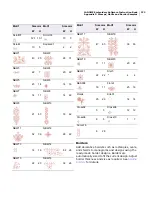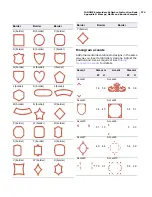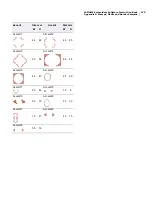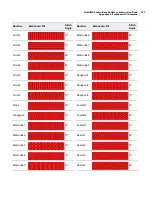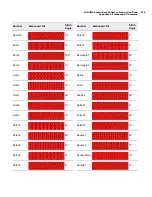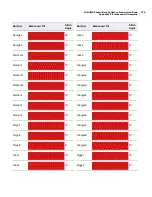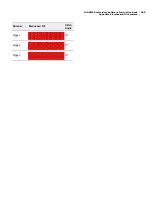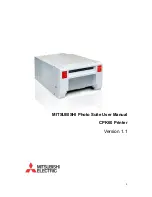
JANOME Embroidery Software Instruction Book
Glossary
287
Click-to-Design: Toolset used to
create embroidery designs by
automatically digitizing electronic
images.
Clipboard: A temporary storage
area in PC memory for what was
last cut or copied. Images on the
clipboard can be pasted into
designs any number of times.
Close button: Used to close a
window or an application. In MS
Windows, it appears as a small box
with an ‘X’ in it at the top-right of
the title bar.
Color depth: Color depth, also
called ‘pixel depth’, refers to the
amount of color information
available to each pixel in an image.
An image with a color depth of 1-bit
can display only two colors. As the
color depth increases, more colors
are available – 16 Colors (4 bit),
256 Colors (8 bit), High Color (16
bit), True Color (24 bit).
Color chart: The color chart
contains a selection of thread
colors tailored for each design. This
color scheme, or ‘colorway’,
represents the actual thread colors
in which a design will be stitched.
See also
Thread chart
.
Color Reduction: See
Image
Preparation
.
Column: Narrow, long, curving
shape.
COM port: A standard serial port
used as a connection point for
peripherals. Other ports may be
present if the appropriate internal
option cards have been installed.
The computer must be informed
which port is being used by which
peripheral – e.g. COM1, COM2, etc.
Command: An instruction issued
to the software in order to carry out
an action. It may be as simple as
‘paste an object’ or as complex as
‘regenerate stitches’. It is usually
activated via a menu item, toolbar
icon, or command button in a
dialog.
Command button: A button in a
dialog which executes or cancels
the selected action. Two common
command buttons are Cancel and
OK.
Condensed file: See
Outline file
.
Configuration: The size and type
of computer hardware. Can also be
used to mean the options provided
with your software.
Confirmation message: A
message displayed by the software
asking you if you are sure you want
to proceed – e.g. when you want to
delete a design.
Connector stitches: Connector
stitches link objects in a design.
They can be run stitches or jumps.
You can use automatic settings to
generate connectors, trims and
tie-offs, or add them manually.
Copy: To place a copy of a
selection onto the clipboard. See
also
Duplicate
.
Control points: Control points
are used to modify object shapes,
stitch angles and entry and exit
points. You can change the shape
of an object by moving, adding or
deleting control points on the
outline. For most objects, you can
also change control points from
corner points to curves.
Copyright: A right granted by the
government or by international
agreement giving the owner the
exclusive privilege to publish and
sell artistic work during the life of
the creator plus 50 years.
Cover stitch: The cover stitch is
the Satin border around an
appliqué shape. You can change
the width of the cover stitch, and
offset it to the inside or outside of
the digitized outline.
Crest: An embroidered motif like
an emblem, an insignia or a Coat of
Arms.
Cross-stitch: Regular Bean stitch
movements that cross at the
center to form an X. Laid in rows or
within a box shape to form
geometric designs. Creates a
handmade appearance.
Custom designs: Designs
created by digitizing artwork or
manipulating existing patterns.
Cut: An editing function. To
remove a selection from a design.
The cut selection is stored in
memory (on the ‘clipboard’) and
can be pasted into the same or
different design.
Cut appliqué: See
Back appliqué
.
Cutter: See
Appliqué cutter
.
Default values: Pre-defined
settings which determine object
properties such as stitch spacing,
as well as certain system settings.
These are stored in the design
template. They remain ‘current’
unless you override them with new
settings. See also
Object properties
and
Current property settings
.
Defects: See
Stitching defects
.
Density: See
Stitch density
or
Thread density
.
Design: A ‘design’ is a file in the
native embroidery format – e.g.
EMB, JAN, ART – of embroidery
digitizing software. The design
source may be a stitch format
design. The design contains
stitching information such as fabric
type in addition to stitched shapes.
Design card: Disk containing
computerized embroidery designs
read by the embroidery machine’s
computer.
Design file: See
File
.
Design library/catalog:
Computer program which catalogs
a collection of digitized designs
kept by embroidery shops that
allows an embroiderer to access
the design by subject, stitch count,
number of colors or icon.
Design object: See
Objects
.
Design properties: Designs
themselves have properties, some
of which can be modified, others
not. The most important design
property is its source – Native
Design, Imported Outlines,
Processed Stitches, or Imported
Stitches. Other properties include
the software version number,
stitch count, and so on.
Design segment: See
Segments
.
Design sequence: See
Stitching
sequence
.
Design source: While
embroidery files are broadly
classified as ‘outline’ (condensed)
or ‘stitch’ (expanded), EasyDesign
internally tags files as belonging to
one of four types–Native Design,
Imported Outlines, Processed
Stitches, or Imported Stitches. See
also
Design properties
.
Design template: See
Template
.
Summary of Contents for DigitizerPro
Page 236: ...234 Part IX Software Feature Table ...

